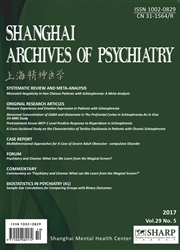

 中文摘要:
中文摘要:
概述:抑郁障碍共患焦虑是常见的精神病理现象。该现象使抑郁障碍临床表现复杂化,并导致治疗困难。通过评定符合抑郁症诊断标准患者的焦虑症状严重程度或者通过确定抑郁症患者是否同时符合焦虑症诊断标准,临床医生评估抑郁症状和焦虑症状之间的重叠程度。然而,中国临床医疗中存在很多因素,往往难以准确评估患者的共患情况。在中国对于这种最常见的精神病理共患现象——抑郁障碍共患焦虑——的诊断缺乏严重削弱了国内对常见精神障碍治疗的有效性。我们认为,中国临床广泛使用有效可靠的评估工具将奇有助于对许多同时存在抑郁症状和焦虑症状的患者的诊断与治疗。
 英文摘要:
英文摘要:
Summary: Comorbid anxiety is common in patients with depressive disorders. It complicates the clinical presentation of depressive disorders and can contribute to treatment resistance. Clinicians can assess the degree of overlap between depressive and anxiety symptoms either by measuring the severity of anxiety symptoms in individuals who meet diagnostic criteria for depression or by determining whether or not an individual with depression simultaneously meets criteria for an anxiety disorder. However, multiple factors in the Chinese clinical setting make it difficult to accurately assess patients with comorbid conditions. The resultant under-diagnosis of comorbid depression and anxiety - the most common type of comorbid psychiatric condition in China - seriously diminishes the effectiveness of treatments for common mental disorders in the country. We argue that the widespread use of valid and reliable dimensional assessment tools in Chinese clinical settings will help improve the diagnosis and treatment of the many individuals who have concurrent depressive and anxiety symptoms.
 同期刊论文项目
同期刊论文项目
 同项目期刊论文
同项目期刊论文
 A study of N-methyl-D-aspartate receptor gene (GRIN2B) variants as predictors of treatment-resistant
A study of N-methyl-D-aspartate receptor gene (GRIN2B) variants as predictors of treatment-resistant Guidelines concordance of maintenance treatment in euthymic patients with bipolar disorder: Data fro
Guidelines concordance of maintenance treatment in euthymic patients with bipolar disorder: Data fro Difference in remission in a Chinese population with anxious versus nonanxious treatment-resistant d
Difference in remission in a Chinese population with anxious versus nonanxious treatment-resistant d Association between brain-derived neurotrophic factor genetic polymorphism Val66Met and susceptibili
Association between brain-derived neurotrophic factor genetic polymorphism Val66Met and susceptibili Atypical features and treatment choices in bipolar disorders: a result of the National Bipolar Mania
Atypical features and treatment choices in bipolar disorders: a result of the National Bipolar Mania Validation of the Chinese Version of the Short TEMPS-A and its application in patients with mood dis
Validation of the Chinese Version of the Short TEMPS-A and its application in patients with mood dis IL-23 and TGF-beta1 levels as potential predictive biomarkers in treatment of bipolar I disorder wit
IL-23 and TGF-beta1 levels as potential predictive biomarkers in treatment of bipolar I disorder wit 期刊信息
期刊信息
